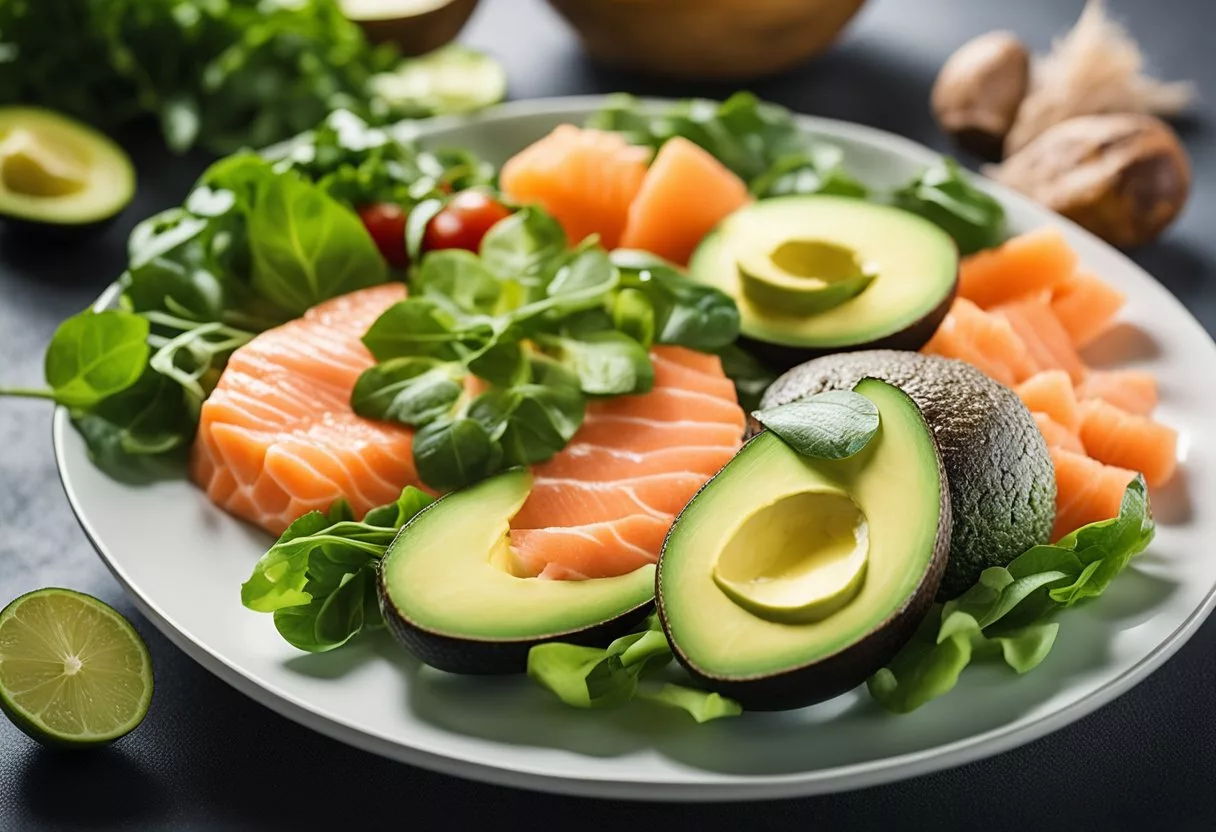The ketogenic diet, commonly known as keto, is a low-carbohydrate, high-fat diet that has gained popularity as a weight loss strategy. By significantly reducing carbohydrate intake and replacing it with fat, the body enters a metabolic state called ketosis.
In ketosis, the body becomes more efficient at burning fat for energy. Moreover, it turns fat into ketones in the liver, which can supply energy for the brain.

Weight loss on the keto diet is driven by this metabolic state, which helps to reduce insulin levels and allows fat burning to increase significantly.
This diet is not only noted for its potential to aid in fast weight loss but also for its ability to possibly reduce hunger and help maintain muscle mass during weight loss.
It has been suggested that a keto diet might be especially effective for excess body fat loss without the feeling of deprivation that comes with other diets.
A properly designed ketogenic diet typically ensures that approximately 70% of daily caloric intake comes from fat, about 25% from protein, and a mere 5% to 10% from carbohydrates.
Despite its benefits for weight loss, it’s important to remember that the keto diet also requires careful planning to ensure nutritional needs are met.
Consulting healthcare providers before starting any new diet is recommended, especially for individuals with pre-existing health conditions.
Keto Diet Basics for Weight Loss

The Ketogenic Diet, often referred to as Keto, is a dietary approach focused on high fat, low carbohydrate intake to induce a metabolic state called ketosis.
The Ketogenic Diet Explained
The Ketogenic Diet places a strong emphasis on fat consumption, requiring approximately 70-80% of daily calories from fats, while significantly reducing carbohydrate intake to typically below 50 grams per day. This drastic shift from a traditional balance of carbohydrates to a diet high in fat and low in carbs aims to transition the body’s primary energy source from glucose to fat.
How Ketosis Works
Ketosis is a metabolic state in which the liver converts fat into fatty acids and ketone bodies. These ketones serve as an alternative fuel source when glucose levels are low, which is typically a result of restricted carbohydrate intake. When the body operates on ketones for energy, it’s said to be in a state of ketosis. This process is marked by a reduction in insulin levels and an increase in fat breakdown.
The Role of Fat in Keto
Fat is the cornerstone of the ketogenic diet and is used to replace the majority of carbohydrates that are usually present in one’s diet. Dietary fat during a Keto diet is not only a source of energy but also aids in satiety and can potentially stabilize blood sugar levels. This high fat requirement means that individuals must carefully select sources of healthy fats and incorporate them into their daily meal planning.
Benefits of a Keto Diet

The ketogenic diet, commonly referred to as keto, has been recognized for its potential in driving weight loss and improving various health markers. This section delves into three core benefits users may experience on a keto diet: effective management of body weight, optimized blood sugar and insulin levels, and enhanced metabolic health.
Weight Loss and Fat Loss
The keto diet primarily functions by forcing the body into ketosis, a metabolic state where fat becomes the main energy source, leading to weight loss and fat loss. Reduced carbohydrate intake depletes the body’s glycogen stores, causing a shift towards fat utilization and resulting in fat loss. People following a keto diet often report a reduction in appetite, which can contribute to a calorie deficit and subsequent weight loss.
Blood Sugar and Insulin Levels
By significantly lowering carbohydrate intake, the keto diet can positively affect blood sugar and insulin levels. This low-carb approach leads to more stable blood sugar levels, which is especially beneficial for individuals with type 2 diabetes. Better control of blood sugar and insulin may also offer protective benefits against heart disease, although evidence is still emerging.
Improved Metabolic Health
Adherents of the keto diet may notice improvements in metabolic health, which includes a range of factors such as blood pressure, cholesterol levels, and fat processing. A keto diet’s impact on metabolic syndrome, a cluster of conditions that increase the risk for heart disease and cancer, can be significant. However, it’s important to monitor dietary choices to ensure they promote cardiovascular health, as the increased fat intake requires careful selection of healthy fats.
Keto Diet Basics

The Keto diet is a dietary approach that prioritizes fats and minimizes carbohydrate intake, aiming to induce a metabolic state known as ketosis.
Foods to Eat
On a Keto diet, individuals focus on consuming a variety of high-fat, low-carb foods. They should prioritize:
- Meat: Beef, pork, lamb, poultry.
- Fish: Especially fatty fish like salmon or mackerel.
- Eggs: Preferably organic or pastured.
- Dairy Products: High-fat dairy such as cheese, butter, and cream.
- Nuts and Seeds: Almonds, walnuts, flaxseeds, pumpkin seeds.
- Healthy Oils: Coconut oil, olive oil, avocado oil.
- Low-Carb Vegetables: Leafy greens like spinach, and cruciferous vegetables like broccoli and cauliflower.
Foods to Avoid
To maintain ketosis, one needs to limit foods high in carbohydrates. Foods to avoid include:
- Sugar: Soft drinks, fruit juices, candies, ice cream.
- Grains: Wheat-based products, rice, pasta, cereal.
- Starches: Potatoes, sweet potatoes, carrots.
- High-Carb Fruits: Apples, bananas, oranges.
- Beans and Legumes: Peas, kidney beans, lentils.
- Low-Fat Dairy Products: Milk, yogurt (especially flavored ones).
- Sweetened Condiments and Sauces: Barbecue sauce, ketchup.
Understanding Net Carbs
Net carbs are calculated by subtracting the grams of fiber from the total grams of carbs, as fiber does not significantly raise blood sugar levels. For the Keto diet, tracking net carbs is crucial:
- Total Carbohydrates minus Fiber equals Net Carbs.
- Most Keto dieters aim for below 20 to 30 grams of net carbs per day.
Regular monitoring of net carb intake helps ensure that one remains within the ketogenic state, promoting fat utilization for energy.
Planning Your Keto Meals

Proper meal planning can lead to successful outcomes on a keto diet by presenting structured and nutritionally sound meal options. This ensures individuals meet their dietary goals, control hunger effectively, and potentially derive other metabolic health benefits.
Creating a Keto Meal Plan
When assembling a keto meal plan, it is crucial to ensure meals consist primarily of fats, accompanied by moderate protein and minimal carbohydrates. Most meal plans follow the Standard Ketogenic Diet (SKD) framework, which typically includes 70-75% fat, 20-25% protein, and 5-10% carbohydrates. Cyclical Ketogenic Diet (CKD) and Targeted Ketogenic Diet (TKD) are variations involving carbohydrate refeeds or targeted carb intake, often used by athletes or for specific dietary needs.
- Fats: nuts, seeds, avocados, olive oil, coconut oil
- Proteins: meat, fish, eggs, cheese
- Carbohydrates: leafy greens, above-ground vegetables
Meal planning should involve calculating individual macronutrient needs and designing meals that align with these targets. It’s helpful to prepare meals in advance to maintain consistency and avoid spontaneity that may lead to non-compliant choices.
Keto-Friendly Recipes
Keto-friendly recipes focus on eliminating starchy vegetables, grains, and sugars, substituting them with high-fat and low-carb ingredients. Recipes range from simple preparation like salads with olive oil and vinegar dressings to more intricate dishes such as cauliflower crust pizzas and zucchini noodles. Websites such as “Diet Doctor” provide detailed recipes and shopping lists to aid in meal preparation and decision-making.
Example Recipe: Cheesy Avocado Keto Omelette
- Eggs (protein)
- Cheese (fat)
- Avocado (fat)
- Spinach (carbohydrate)
Meal Timing and Scheduling
Meal timing and scheduling are individualized in keto diets. Intermittent fasting can be integrated into keto meal planning for those interested in managing hunger and potentially improving weight loss results. It involves periods of eating interspersed with fasting. Snacks are generally not necessary on a well-formulated keto diet due to its satiating nature but having keto-appropriate snacks like cheese cubes or olives can help manage cravings if they arise.
A standard meal schedule could look like:
- Breakfast: 8 AM
- Lunch: 12 PM
- Dinner: 6 PM
If integrating intermittent fasting:
- Eating Window: 12 PM – 8 PM
- Fasting Window: 8 PM – 12 PM the next day
Regular meal timing can help regulate blood sugar levels and metabolic rhythms, which is beneficial for both weight management and overall health.
Dealing with Challenges
Transitioning to a ketogenic diet poses several challenges as one’s body adapts to a new fuel source. Recognizing and managing these hurdles is crucial for sustained success and well-being on the diet.
Keto Flu and How to Overcome It
Keto flu is a common experience as the body shifts from burning carbohydrates to fats. Symptoms may include fatigue, headaches, and irritability.
- Electrolyte Balance: Maintain electrolyte balance by increasing intake of sodium, potassium, and magnesium.
- Hydration: Drink plenty of water to help alleviate symptoms.
- Rest: Ensure adequate sleep to aid the body in adjusting to ketosis.
Dealing with Cravings and Social Situations
Cravings, especially for sugar and high-carbohydrate foods, are typical as the body acclimates to lower carb intake.
- Substitutions: Use keto-friendly sweeteners like stevia or erythritol to satisfy sweet cravings without breaking ketosis.
- Planning: Prepare keto-compliant meals when attending social gatherings to avoid temptation.
- Support: Build a support system for moments of temptation, whether it’s through social media communities or close friends and family.
Managing Weight Plateaus
Weight loss plateaus are a common occurrence and can discourage individuals if not addressed properly.
- Meal Tracking: Keep track of food intake to ensure a caloric deficit is maintained.
- Macronutrient Ratios: Adjust macronutrient ratios if necessary to ensure continued fat burning.
- Intermittent Fasting: Consider incorporating intermittent fasting to help break through the plateau.
Offering strategies such as these equips individuals on a ketogenic diet to confront and conquer the most typical challenges they might face.
Health Considerations
When adopting the ketogenic diet for weight loss, individuals need to be aware of its potential effects on certain health conditions, particularly diabetes and heart health, and must consider special conditions where the diet may need to be adjusted or monitored closely by health professionals.
Keto for Diabetes Management
The ketogenic diet can be a tool for managing diabetes, as it may help to stabilize blood sugar control. Through the limitation of carbohydrates, the diet reduces the body’s need for insulin, which can help against insulin resistance, a common attribute of Type 2 diabetes. However, it’s critical that individuals with diabetes manage this diet under medical supervision to prevent hypoglycemia or other complications.
Keto and Heart Health
Heart health is another crucial consideration while on the keto diet. While some studies suggest that a ketogenic diet can improve the balance between HDL (good cholesterol) and LDL (bad cholesterol) levels, thereby potentially reducing the risk of heart disease, individuals should be cautious about the types of fats consumed. Emphasis should be placed on unsaturated fats and avoidance of excess saturated fats, which can negatively impact blood pressure and lipid profiles.
Keto in Special Conditions
Adhering to the keto diet requires careful consideration in special conditions such as metabolic syndrome, epilepsy, and other specific health conditions. For instance, the diet has been historically used to reduce seizures in epileptic patients when traditional medications are not effective. However, due to the restrictive nature of the diet, anyone with these conditions should embark on the ketogenic journey under professional guidance to ensure their nutritional needs are met and to avoid aggravating their health issues.
Advanced Keto Topics
When delving into advanced keto practices, individuals often explore variations of the standard ketogenic diet and investigate how these alterations can impact exercise performance, muscle maintenance, and overall longevity. These areas require a more nuanced understanding of how the body reacts to dietary changes and physical activity.
Cyclical and Targeted Keto Variants
Cyclical ketogenic diet (CKD) and targeted ketogenic diet (TKD) are two strategies designed for those who engage in high-intensity workouts or athletes seeking to incorporate more carbohydrates strategically while maintaining the benefits of ketosis. Cyclical keto involves periods of higher-carb intake, typically during the weekends, while targeted keto allows for carb consumption around workout times to fuel exercise performance.
Exercise and Muscle Maintenance
On keto, individuals aim to preserve muscle mass while losing fat. Exercise is critical in this process, especially resistance training. Engaging in regular strength exercises can help maintain and even build muscle on a ketogenic diet. One should ensure they consume adequate protein within their daily macro goals to support muscle synthesis and repair.
Keto and Longevity
The potential health benefits of a ketogenic diet may extend beyond short-term weight loss, with emerging research suggesting a link to increased longevity. By reducing carbohydrate intake, one can influence various biomarkers associated with aging and chronic diseases. However, long-term adherence to strict ketogenic diets and their long-range health outcomes require further comprehensive studies.
Supplementation and Keto
When embarking on a ketogenic diet, certain supplements can support nutritional balance and enhance ketosis. These include electrolytes and specific vitamins, as well as exogenous ketones and medium-chain triglyceride (MCT) oils.
Electrolytes and Vitamins
The ketogenic diet involves substantial changes in fluid and mineral balance. Supplements can help maintain proper levels of electrolytes such as sodium, magnesium, and potassium, which are crucial for preventing the “keto flu,” a common temporary side effect during the initial phase of the diet. Additionally, a well-formulated keto diet should provide most necessary vitamins, but there are instances where supplemental vitamins like B and C might be beneficial due to their reduced presence in keto-friendly foods.
Exogenous Ketones and MCTs
Exogenous ketones are supplements that can help individuals achieve ketosis more quickly, providing the body with an immediate source of ketones for energy. MCT oil is a type of fat derived from coconut oil that is rapidly absorbed and converted into ketone bodies by the liver. It can be used as a supplement to increase fat intake and promote a state of ketosis.
| Supplement | Purpose on Keto Diet | Recommended Use |
|---|---|---|
| Electrolytes | Prevent deficiencies and support hydration | As needed, especially during keto-adaptation |
| Vitamins | Ensure adequate micronutrient intake | Daily, based on individual dietary gaps |
| Exogenous Ketones | Aid in entering ketosis faster | Prior to workouts or to alleviate keto flu |
| MCT Oil | Provide a quick source of ketones for energy | In coffee, shakes, or as a salad dressing base |
Incorporating these supplements, if needed, can support a healthy and effective ketogenic lifestyle.
Keto Lifestyle Considerations
Adopting a keto lifestyle involves more than just changing one’s diet. It requires considering how this way of eating will fit into every aspect of life, from daily routines to social interactions. Attention to sustainability, wise choices when eating out, and the cultivation of a supportive community are critical to maintaining this lifestyle successfully.
Sustainable Keto Living
Embarking on a ketogenic lifestyle calls for mindfulness about long-term adherence. Individuals should focus on incorporating a variety of nutrient-dense, high-fat, low-carb foods to ensure they obtain essential vitamins and prevent dietary fatigue. Sustainability also means being prepared for situations that may challenge one’s diet, such as social gatherings or periods of stress, by having strategies in place to stay on track.
Navigating Eating Out
When following a ketogenic diet, eating out can present challenges due to limited control over ingredients and preparation methods. However, with careful planning, individuals can find keto-friendly options at most restaurants by:
- Asking for substitutions: Swap out high-carb sides like fries for vegetables or salad.
- Requesting modifications: Opt for dishes that can be easily modified to fit keto parameters, such as a burger without the bun.
- Checking menus beforehand: Review the menu online before visiting to identify possible keto-friendly dishes.
Building a Supportive Community
Having a support network is vital for anyone pursuing a ketogenic lifestyle. This community can provide encouragement, share resources, and offer guidance. Individuals can seek out local or online groups, connect with others through social media platforms, or even involve friends and family in their journey. A supportive community helps individuals feel less isolated and more motivated to maintain their lifestyle changes.
Maintaining Keto Long-Term
Transitioning to a ketogenic diet can lead to significant weight loss and health benefits. However, maintaining a state of ketosis long-term requires careful adaptations, avoiding pitfalls, and embracing keto as more than a diet, but as a sustainable lifestyle.
Adaptations Over Time
Initially, individuals may experience dramatic weight loss predominantly from water and glycogen stores. Over time, keto adaptation occurs, where the body becomes more efficient at burning fat for fuel, a metabolic state known as ketosis. This adaptation may take several weeks to months and can lead to a more stable level of weight loss. It is important for individuals to listen to their body’s signals and adjust their macronutrient intake accordingly to maintain ketosis.
- Energy Levels: Improved energy levels can be a sign of successful keto adaptation.
- Appetite Regulation: Many individuals notice a natural reduction in hunger.
Avoiding Common Mistakes
Common mistakes can interfere with long-term adherence to the keto diet. These include:
- Not Counting Net Carbs: Intake should be between 20 to 50 grams of total carbohydrates, focusing on net carbs (total carbs minus fiber).
- Overeating Calories: Despite its high-fat approach, calorie intake should not be ignored.
- Neglecting Nutrient Density: It’s imperative to consume nutrient-dense foods to avoid deficiencies.
It’s crucial to not only monitor carbohydrate intake but also ensure an adequate intake of protein and fats.
Making Keto a Lifestyle
For long-term success, the ketogenic diet should be considered a lifestyle change rather than a temporary fix. This involves:
- Consistency: Maintaining a regular pattern of eating low-carb, high-fat foods.
- Flexibility: Adjusting the diet to real-life situations to enhance sustainability.
- Mindset: Developing a ‘no excuses’ attitude towards staying on track.
By integrating keto-friendly choices into everyday routines, individuals can continue to experience the benefits of a ketogenic lifestyle for years to come.
Frequently Asked Questions
The Keto diet has gained attention for its effectiveness in weight loss. This section provides answers to common inquiries about the diet’s basics, weight loss mechanisms, potential side effects, snack ideas, long-term outcomes, and expected weight loss timeline.
What are the essential foods to include in a beginner’s Keto diet plan?
Beginners should focus on including healthy fats like avocados and nuts, proteins such as eggs and lean meats, and low-carb vegetables like spinach and broccoli. It’s crucial to minimize carbohydrate intake to maintain ketosis.
How does a Keto diet contribute to weight loss?
A Keto diet contributes to weight loss by shifting the body’s metabolism towards burning fat for energy instead of carbohydrates, a state known as ketosis. This can lead to a reduction in fat stores and promote weight loss.
What potential side effects should one be aware of when starting a Keto diet?
Individuals may experience the “keto flu,” which includes symptoms like headaches, fatigue, and dizziness, during the initial transition to ketosis. Staying hydrated and ensuring adequate electrolyte intake can help mitigate these effects.
Can you recommend some Keto-friendly snacks for weight loss?
Keto-friendly snacks for weight loss include celery with almond butter, cheese cubes, olives, hard-boiled eggs, and nuts. These snacks are low in carbs and can help maintain satiety between meals.
What are the long-term benefits and possible risks of maintaining a Keto diet?
Long-term benefits of a Keto diet can include sustained weight loss, improved blood sugar control, and better heart health. Possible risks might consist of nutrient deficiencies and kidney stones if the diet is not well-balanced.
How rapidly can one expect to lose weight after starting a Keto diet regimen?
Weight loss can be quite rapid in the initial stages of a Keto diet, often due to loss of water weight. Fat loss usually follows, but the rate can vary based on individual metabolic factors and adherence to the diet’s principles.
